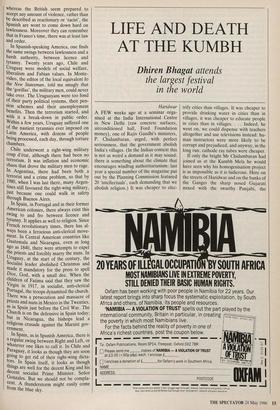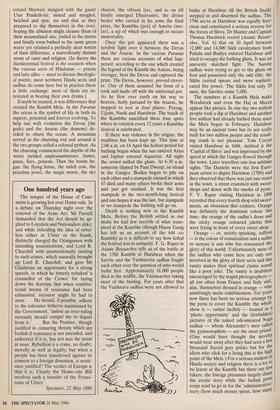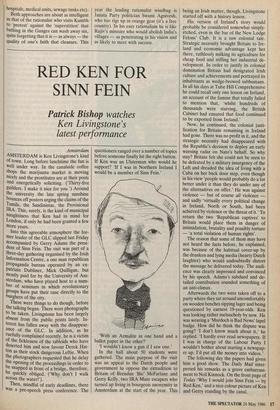LIFE AND DEATH AT THE KUMBH
Dhiren Bhagat attends
the largest festival in the world
Haridwar A FEW weeks ago at a seminar orga- nised at the India International Centre in New Delhi (raw concrete surfaces, airconditioned hall, Ford Foundation money), one of Rajiv Gandhi's ministers, P. Chidambaran, urged, with perfect seriousness, that the government abolish India's villages. (In the Indian context this is not as weird a demand as it may sound: there is something about the climate that encourages windbag authoritarianism: last year a special number of the magazine put out by the Planning Commission featured 20 'intellectuals', each demanding that we abolish religion.) It was cheaper to elec- trify cities than villages. It was cheaper to provide drinking water in cities than in villages, it was cheaper to educate people in cities than in villages. . . . Indeed, he went on, we could dispense with teachers altogether and use televisions instead: hu- man instructors were more likely to be corrupt and prejudiced, and anyway, in the long run, cathode ray tubes were cheaper.
If only the bright Mr Chidambaran had joined us at the Kumbh Mela he would have seen why his homogenisation project is as impossible as it is ludicrous. Here on the streets of Haridwar and on the banks of the Ganges the sharp nosed Gujarati mixed with the swarthy Punjabi, the
rotund Marwari mingled with the gaunt Utar Pradesh-ite; mixed and mingled, belched and spat, ate and shat as they prepared to dip themselves in the river, hoping the ablution might cleanse them of their accumulated sins; jostled in the streets and finally even bathed in the same green water yet retained a perfectly clear notion of their difference, a marvellously distinct sense of caste and religion. (In theory the duodecennial festival is the occasion when the various sects of Hinduism — priests and laity alike — meet to discuss theologic- al points; most northern Hindu sects and sadhus do come here but in practice there is little exchange: most of them are in- terested in beating their own drums.) If myth be trusted, it was differences that created the Kumbh Mela. In the Puranas the ocean is the symbol of life in both its aspects, potential and forever evolving. To help out with evolution the Devas (the gods) and the Asuras (the demons) de- cided to churn the ocean. A mountain served as the churning rod and around it the two groups coiled a colossal python. As the churning commenced the depths of the water yielded unpleasantnesses: fumes, gases, fires, poisons. Then the boons be- gan: the flying horse, the milch cow, the priceless jewel, the magic moon, the sky chariot, the vibrant lyre, and so on till finally emerged Dhanvantri, the divine healer who carried in his arms the final prize, the Kumbha (pot) of Amrita (nec- tar), a sip of which was enough to secure immortality.
Once the pot appeared there was a terrible fight over it between the Devas and the Asuras. In the various Puranas there are various accounts of what hap- pened; according to the one which created the legend of the Kumbh the Asuras, being stronger, beat the Devas and captured the prize. The Devas, however, proved clever- er. One of them assumed the form of a rook and made off with the ambrosial pot. As he flew over earth on his way to heaven, hotly pursued by the Asuras, he stopped to rest at four places: Prayag, Ujjain, Nasik and Haridwar. The touch of the Kumbha sanctified these four spots where in rotation every 12 years a Kumbha festival is celebrated.
If there was violence in the origins, the tradition has been kept up. This time at 2.06 a.m. on 14 April the holiest period for bathing began when the sun entered Aries and Jupiter entered Aquarius. All night the crowd milled the ghats. At 6.30 a.m. someone slipped by Pant Dweep, an island in the Ganges. Bodies began to pile on each other and a stampede ensued in which 47 died and many others broke their arms and just got crushed. It was the first stampede in the two-month-long festival and one hopes it was the last, but stampede or no stampede the bathing will go on.
Death is nothing new at the Kumbh Mela. Before the British settled in our midst we had few records of what trans- pired at the Kumbhs (though Hiuen Tsang has left us an account of the 644 AD Kumbh) so it is difficult to say how lethal the festival was in antiquity. F. G. Raper in Asiatic Researches tells us of the battle at the 1760 Kumbh at Haridwar when the Saivite and the Vaishnavite sadhus fought each other over the question of who would bathe first. Approximately 18,000 people died in the scuffle, the Vaishnavites taking most of the beating. For years after that the Vaishnava sadhus were not allowed to bathe at Haridwar till the British finally stepped in and disarmed the sadhus. The 1796 set-to at Haridwar was equally fero- cious and constituted a serious reverse for the forces of Shiva. Dr Hunter and Captain Thomas Hardwick record (Asiatic Resear- ches, Vol. 6) that on 10 April between 12,000 and 14,000 Sikh cavalrymen from Patiala and Budiya entered Haridwar and tried to occupy the bathing ghats. It was an unevenly matched fight. The Saivite sadhus were trying to get to the ghats on foot and possessed only the odd rifle: the Sikhs carried spears and more sophisti- cated fire power. The Sikhs lost only 20 men, the Saivites some 5,000.
The numbers at a Kumbh Mela make Woodstock and even the Haj at Mecca appear like picnics. In one day two million people took a dip at Haridwar and another five million had already bathed there since the Mela began in February. Haridwar may be an ancient town but its not really built for two million people and the result- ing crush is not pleasant. Tom Coryat visited Haridwar in 1608, dubbed it the `Capital of Shiva' and was impressed by the speed at which the Ganges flowed through the town. Later travellers saw less sublime sights. The Daniells were the first Euro- pean artists to depict Haridwar (1789) and they observed that there was just one street in the town, a street crammed with sweet- shops and dense with the smoke of pyres. F. V. Raper visiting Haridwar in 1808 recorded that every fourth shop sold sweet- meats, an obsession that endures. Orange was definitely the dominant colour this time: the orange of the sadhu's dress and the sticky orange coloured jalebis that were frying in front of every sweet shop. Orange — or, strictly speaking, saffron — is the colour of renunciation and a sadhu or sanyasi is one who has renounced the glory of this world. Unfortunately most of the sadhus who come here are only too involved in the glory of their sects and this vanity makes their spiritual claims sound like a poor joke. The vanity is doubtless encouraged by the stupid photographers — all too often from France and Italy and, alas, themselves dressed in orange — who unwittingly incite exhibitionism. For years now there has been no serious attempt by the press to cover the Kumbh; the whole show is — rather facilely — treated as a `photo opportunity' and the (forbidden) pictures of the naked ash-smeared Naga sadhus — whom Alexander's men called the gymnosophists — are the most prized. (One would have thought the novelty would wear away after they had seen a few thousand flaccid grey pricks but for the idiots who click for a living this is the high point of the Mela.) For a serious student of Hindu society and religion there is a lot to be learnt at the Kumbh but there are feW takers: the foreign pressmen largely chase the exotic story while the Indian Press, corps tend to go in for the 'administrative story (how much money spent, how many hospitals, medical units, sewage tanks etc).
Both approaches are about as intelligent as that of the rationalist who visits Kumbh to 'protest' against the 'superstition' that bathing in the Ganges can wash away sin, quite forgetting that it is — as always — the quality of one's faith that cleanses. This year the leading rationalist windbag is Janata Party politician Swami Agnivesh, who too rigs up in orange gear (it's a free country). In his easy rationalism he is like Rajiv's minister who would abolish India's villages — as penetrating in his vision and as likely to meet with success.
















































 Previous page
Previous page